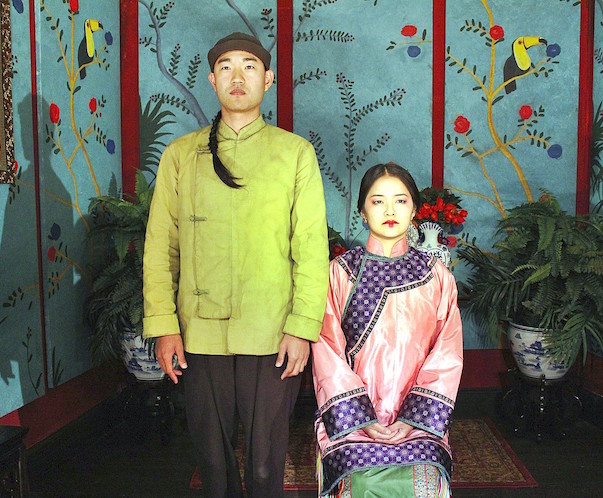Theater Review: “The Chinese Lady” — History as a Clever Two-hander
Atung and Moy have a lot to say about American history and culture — acutely informed by the playwright’s 21st century sensibility and identity politics.
The Chinese Lady written by Lloyd Suh. Directed by Ralph B. Peña. A co-production of Ma-Yi Theater Company and the Barrington Stage Company at the St. Germain Stage, Pittsfield, MA through August 11.

Shannon Tyo as Afong Moy, the first woman to come from China to the U.S., and Daniel K. Isaac as her translator, Atung, in the world premiere of “The Chinese Lady.” Photo: courtesy of the Barrington Stage Company.
By Helen Epstein
In 1834, the Carne brothers of Beverly, Massachusetts, China trade importers of home furnishings for the burgeoning American middle class, hit upon a marketing idea: they would import a living Chinese lady — probably the first Chinese woman ever seen in the United States — and exhibit her in a facsimile of her exotic surroundings. They would charge admission and boost sales of their imports — wall hangings, lanterns, tea sets — at the same time. They bought the young woman from her father — who lived outside Canton — and promised to take her back to China after two years. Her name was Afong Moy, she was 19 years old, and she was accompanied by an interpreter named Atung.
“Unlike most acts from this period,” wrote cultural historian John Haddad, “Afong Moy did not juggle, work with trained animals, or profess to communicate with the dead,” as did most of the performers in traveling side shows of the time. Almost a decade before the first large wave of Chinese immigration to the U.S., Americans lined up to stare at an upper-class Chinese lady who could barely walk because she had undergone the practice of foot-binding.
Her feet were four inches long. “Men in the audience tended to fixate on her small feet, deeming them inexhaustible sources of anatomical fascination, moral disgust, or erotic pleasure,” Haddad noted. “While women also studied Moy’s feet, they were equally drawn to her surroundings — a luxurious setting composed of Chinese home furnishings and decorative objects.”
The Barrington Stage Company audience walks in to see an enormous blue container on a bare stage. As the play begins, the doors open up to display a replica of Moy’s parlor: a pleasing and efficient set by Junghyun Georgia Lee. Director Ralph B. Peña has assembled a splendid design team that complements the set, including Lee’s careful costume design, subtle lighting by Oliver Wason, and intriguing sound design by Fabian Obispo.
Lloyd Suh’s script opens with Moy’s startling introduction:
Hello. My name is Afong Moy…I will be here for your education and entertainment. I will be on display here at Peale’s Museum, at 3pm and 7:30pm on select Tuesdays through Sundays, at a price of 25 cents adults, 10 cents children. Thank you for coming to see me.
Though Atung is introduced as her interpreter, Moy says (in perfect English):
We will not be needing Atung’s translation services for the time being, for I am not speaking. It would of course seem that I am speaking, as my mouth is moving and my thoughts are becoming articulated through sound, but this is not in fact what is happening. What is happening is a performance. For my entire life is a performance. The words I am speaking are not my own. The clothes I am wearing are not my own. This Room in which I am seated is intended to be representative of China, just as I am intended to be representative of The Chinese Lady: the first woman from the Orient ever to set foot in America, and yet this Room is unlike any room in China, and I am unlike any lady to ever live.
I was mostly charmed by Tyo’s forthright and sprightly performance as Afong Moy, which manages to fudge the script’s self-conscious disconnect between realism and what is a kind of magic show. In a series of scenes that move from her arrival in 1834 to a posthumous appearance in 2018, she delivers her lines with aplomb and walks the fine line between the everyday and fantasy, a compendium of what Suh believes would be the first impressions of this teenage girl on exhibit in America.
I have been sleeping on a bed that is elevated some three feet above the floor. I hope I do not fall off of it! … I am ambivalent about the fork. I have seen it in use and I understand its functionality; it seems a useful tool for the stabbing of food, but ultimately, I feel it lacks grace. Chopsticks are elegant and poetic. Forks are violent and easy.
Daniel K. Isaac is delightfully sly and cheeky as Carnes’ employee as well as Moy’s interpreter Atung. He serves as a comedic foil to the sometimes priggish lady; their exchanges are fun to watch. But that does not make up for a considerable weakness in The Chinese Lady: there is no plot and little character development. In place of dramatic conflict, we get a sometimes biting history lesson, including an imagined recreation of Moy’s audience with President Andrew Jackson in Washington, D.C.
From their elegant setting of chinoiserie, Atung and Moy have a lot to say about American history and culture — acutely informed by the playwright’s 21st century sensibility and identity politics. The play has been in development for several years, but it resonates more powerfully since the 2016 election.
I left the theater feeling that this script needed more work, but was pleased to have been introduced to Afong Moy and Atung.
Helen Epstein in the author of Joe Papp: An American Life and other books about the arts, available at Plunkett Lake Press. She has been reviewing for the Arts Fuse since its inception.
Tagged: Barrington Stage Company, Culture Vulture, Lloyd Suh, Ma-Yi Theater Company
